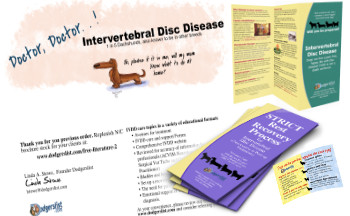Jeanne it appears that Duncan would surely be graduated bynow if the neuro ended up wanting 6 weeks of post op rest to heal the surgical areas.
If that is the case, below is how you would gradually and safely transition him back to family life and activity. It is still very early in the nerve healing department.
Nerves recover slowly, and maximal recovery may take many months or several years.
Some dogs can heal their damaged nerves faster than others. Once nerves have repaired then muscles will also have to be retrained to relearn proper placement of the paws. Some muscles will need to regain strength for walking. Consider learning to walk again as it would be for a stroke victim or a baby learning to walk. At first, the steps will be weak and a bit unstable. Relearning to walk takes coordination, building up strength, and lots of patience. It is very normal for recovery to be gradual over the course of months rather than days/weeks. Expect plateaus where your dog doesn’t seem to improve. Inside where you can't see nerves are at work regenerating til the next connection can be made. When the connection is made then on the outside, then you can observe the result!
GRADUATION, A SLOW RE-INTRODUCTION Determine how you are going to ease back into more normal activity at graduation from rest. The idea is to gradually give Duncan more freedom under controlled conditions. Not free rein of the house and yard immediately! LOL
Your dog's muscles are soft and out of shape after the rest period. Gradually build up their muscles and their lungs.
Take a look at our information. Gradually building your dogs muscles over a month's time will have your dog safely wobbly walking and having fun again!
SAMPLE SCHEDULE
Here is a sample schedule to safely and slowly introduce your dog back to family life and physical activity:
dodgerslist.com/2020/06/15/back-friendly/?highlight=sample%20scheduleDIY back PROTECTION around the house 
**
1) Good ideas in making your home back friendly:
dodgerslist.com/2020/07/09/home-protect-ivdd-backs/2) Ideas and products to provide improved traction for wobbly dogs:
dodgerslist.com/2022/10/08/traction-solution-improvements/3) Teach your dog to be safe and not jumping up or down, but to use a ramp whether over steps leading outdoors or up/down to furniture in the house.
Dogs are best at visual learning rather than verbal commands. Dog trainer Anna Jane Grossman says “Dogs learn in pictures. Inside your dog’s brain is a very simple algorithm – pleasant images in one place and unpleasant images in another."
HAPPY DAYS AHEAD
You and Duncan have survived a disc herniation! Learn what you can do from this point forward. Lots more ideas and tips in living with an IVDD dog such as dentals, nail trims, safe ways to have fun together, and more:
dodgerslist.com/living-with-ivdd-tips-2 PT THERAPY AT CLINIC or HOME Safety first. You should always consult with a veterinarian before starting any exercise program with your dog. For example, although senior dogs need to stay limber, severe arthritis might make certain movements inappropriate.
-- Water therapy:
dodgerslist.com/2020/05/28/surgery-dog-water-therapy-- Strengthening core muscles.
This applies not just for humans, but REALLY does apply to the IVDD dog: "...
improve the strength and coordination of the muscles that surround the spine so they can act like the world's greatest back and neck brace."
www.spineuniverse.com/conditions/spondylosis Core exercises don't require specialized equipment. Here are 5 exercises you can do at home:
totofit.com/five-basic-exercises-essential-to-building-core-strength/Jeannie , may we turn the tables and ask YOU for help?
Did you know there are less than a handful who volunteer daily to help dogs and their owners? We need helping hands from other Forum members in educating.
Disc disease is our number one mission!
We invite you to hop on to our educational bandwagon team. Too many dogs are put to sleep because owners lack education about IVDD treatment. STRICT crate rest and proper medication have helped many dogs recover or maybe to avoid a surgery. We depend on all members to pay it forward for the help they have received with their dog by helping us educate!
Pick what suits you....
We depend on you. Here are some ways to help..
-- "Share" our FB posts
www.facebook.com/Dodgerslist-- When in conversation at the grocery store line or wherever you may meet breeds most prone to IVDD (Dachshunds, Beagles, Poodles, Spaniels, Shih Tzus, Pekingese, and Chihuahuas, Frenchies) give out our free little wallet cards.
Hand carry our literature and print out our letter of introduction for your vet.
►Today
ORDER BROCHURES & cards, they're free!◀︎]
dodgerslist.com/free-literature-2/ for your vet and wallet cards for you
-- Would you consider helping another trying to make decisions about surgery?
We have a directory where you can share surgical info.
Here is where you can share your dog's info:
dodgerslist.boards.net/board/13/member-reported-surgery-costs-recommendationsState:
Hospital:
Address:
Cost:
Date of surgery:
What was included in cost (MRI?, days stay, ER? PT? meds for home, sling, etc.)
Comments:
And finally,
don't be a stranger! Stop in periodically. We really do love to hear how your dog is doing. We'd love a short video clip to see Duncan in action at home, at PT and living & loving life in spite of IVDD!
if you see a new member in a tough spot, give them hope. A brief paragraph about your dog can be insanely supportive and inspiring in a time of need!



 **
**

